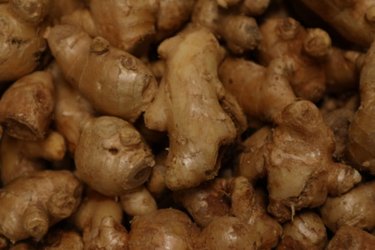
The common ginger plant (Zingiber officianale) has a long history as a culinary and medicinal herb. The Chinese have used ginger to treat stomach distress and nausea for over 2,000 years. Headaches, nausea, and arthritis, are some other conditions ginger is thought to alleviate. Some studies have shown that ginger helps relieve pregnancy related nausea and vomiting and can reduce incidents of motion sickness. Ginger is also valued in many parts of the world as a cooking spice.
Root and Rhizome
Video of the Day
The ginger's roots are the part of the plant used in herbal medicine and food preparation. The word "roots" is a misnomer, since they are actually rhizomes. Rhizomes are underground stems which have buds and nodules. The true roots of the plant grow out of the rhizomes, but it is the rhizomes which you see in grocery and health food stores sold as "ginger root." You can grow a new plant from the rhizomes as long as they are not subjected to freezing temperatures.
Video of the Day
Leaves
Ginger has narrow lance-shaped leaves that grow on opposite sides of a branch 180 degrees apart. They develop in an alternate arrangement. This means that leaves on the same branch never grow directly opposite each other, but alternate on the branch in an ascending spiral pattern. Ginger leaves are sometimes used in ginger-producing countries as a food flavoring, though this is less common than the use of the rhizome.
Flowers
The ginger plant has white or yellow-green flowers that blossom on a stalk growing directly out of the rhizome. The top of the stalk has a spike consisting of many bracts, or scale-like leaves. Each bract produces one or more flowers which bloom for only a few days. The flowers are edible and make a delicious garnish, according to the Cornell University Cooperative Extension.